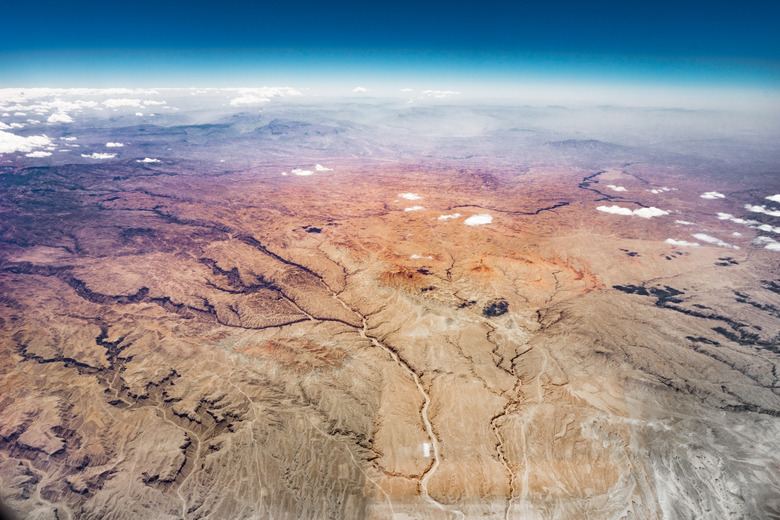What Is The Difference Between The Crust & The Lithosphere?
When discussing the composition of the Earth as a whole, geologists conceptually divide the Earth into several layers. One of these layers is the crust, which is the outermost part of the planet. The lithosphere is not an individual layer, but rather a zone made up of two of the layers of the Earth, which includes the crust.
The Layers of the Earth
The Layers of the Earth
The Earth consists of three primary layers: the crust, the mantle and the core.
The core, the innermost layer, is rich in iron and very dense. The core consists of the outer core (bordering the mantle) and the inner core (at the very center of the Earth). The outer core reaches extremely high temperatures and consists of molten/liquid nickel and iron, but the inner core actually experiences such intense pressures that it remains static, though not exactly solid.
The mantle is the intermediate layer of the Earth and can be subdivided into the inner and outer mantle. Most of the mantle is a thick fluid that moves in currents, but the very outermost portion of the outer mantle is solid. This portion and the solid crust make up the lithosphere. The uppermost part of the mantle is part of the lithosphere, while the lower mantle makes up part of the asthenosphere.
The crust is the part of the Earth that we interact with. While an extremely thin layer compared to the scale of the Earth, the crust extends nearly 70 km until reaching the mantle (this is equivalent to nearly 9 times the height of Mount Everest).
The Mantle and the Lithosphere
The Mantle and the Lithosphere
The mantle is made up of molten rock called magma. This magma circulates in currents determined by the cooling and sinking of heavier minerals with the heating and rising of lighter minerals. All but the very outermost portion of the mantle is part of the asthenosphere, which refers to the liquid zone of the inner Earth. The outer portion of the mantle makes up the bottom portion of the lithosphere. On average, it is 30 kilometers thick, but its thickness depends on the age of that portion of the lithosphere, temperature, and pressure conditions. The mantle consists largely of heavy ultramafic rock like olivine.
TL;DR (Too Long; Didn't Read)
The Mohorovičić Discontinuity, or Moho, designates the boundary between the crust and the mantle. It lies mostly within the lithosphere, but under some mid-ocean ridges, the solid rock of the lithosphere transitions to the asthenosphere where the mantle becomes more ductile and liquid.
The Crust and the Lithosphere
The Crust and the Lithosphere
The crust makes up the upper portion of the lithosphere. It is made up of lighter materials than the mantle and core, like mafic and felsic rock. While it is the thinnest layer of the Earth at only 60 to 70 kilometers thick, it makes up the majority of the lithosphere, and it is the portion of the Earth that supports life. The crust surface is shaped by characteristics of the lithosphere that cause formations like mountains and fault lines. The part of the crust that makes up continents is formed of lighter minerals than the part of the crust that makes up the ocean basins and seafloor, like basalt.
TL;DR (Too Long; Didn't Read)
The chemical composition of many of these minerals is very similar, but the formation and mechanical properties of these minerals leads to the variation in the outermost layer.
The Importance of Earth’s Lithosphere Layer
The Importance of Earth's Lithosphere Layer
The lithosphere, unlike the layers of the Earth, is defined not by composition but by behavior. The lithosphere is cold, relative to the fluid asthenosphere at least, and solid (in Earth Science the asthenosphere might be referred to as ductile or malleable). It floats freely on top of the liquid magma of the upper mantle and is divided into discrete sections known as tectonic or lithospheric plates. These divisions participate in a cycle of deformation, seismic waves, and movement in the outer layer of the Earth.
These plates can be further classified as continental plates (or continental crust) and oceanic plates (or oceanic crust). These boundaries between tectonic plates have a profound effect on the shape of the surface of the earth (described through the theory of plate tectonics) in the Earth's crust. A boundary that moves longitudinally is known as a transform fault line and causes earthquakes. Volcanic activity occurs at convergent boundaries (often called subduction zones) and forms continental landmasses, while divergent boundaries cause a magma upwelling that forms the ocean floor.
The thickness of the lithosphere can be variable, with older portions being thicker, but it tends to have an average width of 100 kilometers. Young portions of the lithosphere are formed by the downward movement and melting of one tectonic plate beneath another at a boundary known as a subduction zone. The makeup and thickness of this layer also varies between the continental lithosphere and the oceanic lithosphere (whether it is a continental plate or an oceanic plate).
The convection and movement of the Earth's interior asthenosphere influences the movement and activity at the plate boundaries. The study of these processes in geophysics delves into the structure of the Earth.
Cite This Article
MLA
Asta, Jean. "What Is The Difference Between The Crust & The Lithosphere?" sciencing.com, https://www.sciencing.com/difference-between-crust-lithosphere-8593505/. 11 July 2023.
APA
Asta, Jean. (2023, July 11). What Is The Difference Between The Crust & The Lithosphere?. sciencing.com. Retrieved from https://www.sciencing.com/difference-between-crust-lithosphere-8593505/
Chicago
Asta, Jean. What Is The Difference Between The Crust & The Lithosphere? last modified July 11, 2023. https://www.sciencing.com/difference-between-crust-lithosphere-8593505/
